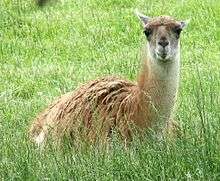Lamini
| Lamini | |
|---|---|
.png) | |
| Llama | |
| Scientific classification | |
| Kingdom: | Animalia |
| Phylum: | Chordata |
| Clade: | Synapsida |
| Class: | Mammalia |
| Order: | Artiodactyla |
| Family: | Camelidae |
| Tribe: | Lamini |
| Genera | |
Lamini (members are called laminoids) is a tribe of the subfamily Camelinae. It contains two genera and four species, all exclusively from South America: llamas, alpacas, vicuñas, and guanacos. The former two are domesticated species, while the latter two are only found in the wild. All lack sexual dimorphism. The four species can interbreed and produce fertile offspring.[1]
The digestive system of lamoids allows them to digest certain toxins.[2] Laminoids also lack a gallbladder.[3]
Characteristics
Alpaca (Vicugna pacos)
The alpaca, a domestic camelid, weights between 50 and 65 kg (110 and 143 lb), while its height at the shoulder is 94–104 cm (37–41 in). It is slightly larger than the vicuña. Normally, the alpaca is found in the Andes in Peru and Bolivia, though it also inhabits northern Chile and northwestern Argentina.[4] There are about 3.5 million alpacas in the world. In the 1980s, alpacas started being exported to other countries for farming purposes: they can be found in the United States, Australia, and New Zealand, though the vast majority still reside in South America.[5]
The alpaca is mainly used for its wool. Out of the domestic camelids, the alpaca produces wool with longer and finer fiber than the llama,[4] with a diameter of 18–25 micrometers per strand.[6]

Guanaco (Lama guanicoe)
The guanaco is a wild camelid, standing at 100–120 cm (39–47 in) at the shoulder[4] and 150–160 cm (59–63 in) at the head. It can weigh up to 140 kilograms (310 lb).[7] Its pelage is longer than that of the vicuña but shorter than that of the alpaca; it is considered to be of excellent quality and has a light brown, reddish, or brown-yellow color.[8] The diameter of its fleece's fibers varies between 16 and 18 micrometers.
90% of the world's guanacos are in Argentina,[8] distributed from the islands of the Beagle Channel and the southern extremity of the Patagonia to the Puna grassland in northeastern Argentina. Guanacos can also be found in Bolivia, Chile, Paraguay, and Peru.[9]
Llama (Lama glama)
The llama is the largest of the extant laminoids and weighs 130–150 kilograms (290–330 lb) with a height of 109–119 cm (43–47 in) at the shoulder.[4] Llamas are not a natural species; rather, they were domesticated by the Peruvians and Bolivians of the highlands.[10] Commercial trade led to the llama's current abundance in Colombia, Ecuador, Peru, Bolivia, Chile, Paraguay, and northeast Argentina. There are bands of llamas in the United States, Europe, Japan, and New Zealand.
The color and length of the llama's wool is variable, depending on the race. The diameter of llama wool's fiber varies between 20 and 80 micrometers, depending on whether the llamas were raised for its wool or as a pack animal.
Vicuña (Vicugna vicugna)
The vicuña is the smallest camelid, with a shoulder height of 75–100 cm (30–39 in) and a weight of 40–60 kg (88–132 lb). Its coat is mainly beige in color and is said to make "the best wool in the world", with the average fiber diameter between 11 and 14 micrometers.[11] Like rodents, the vicuña has continuously-growing incisors. It lives only in areas of high altitude – 3,200 m (10,500 ft) or greater – in the highlands of Argentina, Bolivia, Chile, Peru, and Ecuador.
See also
References
- ↑ Wheeler, Jane C. (2012). "South American camelids - past, present and f uture" (PDF). Journal of Camelid Science. 5: 13. Retrieved 25 February 2016.
- ↑ Fowler, Murray E. (1998). Medicine and surgery of South American camelids: llama, alpaca, vicuña, guanaco (2nd ed.). Ames, Iowa: Blackwell. ISBN 0813803977.
- ↑ Hogan, C. Michael (2008). Strömberg, N., ed. "Guanaco: Lama guanicoe". GlobalTwitcher.
- 1 2 3 4 Stahl, Peter W. (4 April 2008). "Animal Domestication in South America". In Silverman, Helaine; Isbell, William. Handbook of South American Archaeology. Springer. pp. 121–130. ISBN 9780387752280.
- ↑ Castillo-Ruiz, Alexandra. "Lama pacos: alpaca". Animal Diversity Web. University of Michigan. Retrieved 10 December 2012.
- ↑ Quiggle, Charlotte (Fall 2000). "Alpaca: An Ancient Luxury". Interweave Knits: 74–76.
- ↑ "Guanaco: Lama guanicoe". World Association of Zoos and Aquariums. Retrieved 10 December 2012.
- 1 2 "San Diego Zoo's Animal Bytes: Guanaco". Zoological Society of San Diego. Retrieved 10 December 2012.
- ↑ Baldi, B.; Lichtenstein, G.; González, B.; Funes, M.; Cuéller, E.; Villalba, L.; Hoces, D.; Puig, S. (2008). "Lama guanicoe". IUCN Redlist. International Union for Conservation of Nature and Natural Resources. Retrieved 11 December 2012.
- ↑ Furlong, Charles Wellington (October 1912 – March 1913). "Hunting the Guanaco". The Outing Magazine. 61 (1): 5.
- ↑ "Mammal Guide: Vicuña". Animal Planet. Discovery Communications, LLC. Retrieved 11 December 2012.